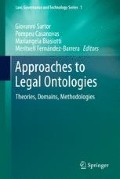Abstract
Ontologies have come of age in the legal field. A certain number of ontologies in different domains are already available and have been used in various applications. However, as a result of the growing of the field, a plurality of theoretical and methodological approaches has flourished. The multi-level complexity involved in legal ontology engineering suggests that there is no single way to address the development of legal ontologies, but rather we have a cluster of problems, perspectives, instruments, and goals that require a plurality of approaches, both on theoretical and on pragmatic grounds. This chapter, after introducing some challenges and new lines of development in the intersection of legal ontologies and next Semantic Web generation, briefly presents the contributions in the volume.
Access this chapter
Tax calculation will be finalised at checkout
Purchases are for personal use only
Notes
- 1.
See a summary of ALIS, ARGUGRID, ASPIC, BEST, DALOS, ESTRELLA, OPENKNOWLEDGE.META-SEARCH, SEAL and SEKT, in Sartor et al. (2008: 8–16).
References
Breuker, J., P. Casanovas, M.C.A. Klein, E. Francesconi (2009). The Flood, the Channels, and the Dykes: Managing Legal Information in a Globalized and Digital World. In J. Breuker et al. (Eds.) Law, Ontologies and the Semantic Web. Channelling the Legal Information Flood, Frontiers in Artificial Intelligence and Applications n. 188, IOS Press, Amsterdam, 2009, 3–20.
Cardoso, J. (2007). The Semantic Web Vision: Where We Are. IEEE Intelligent Systems, September/October, 2007, 22(5): 84–88.
Casanovas, P. (2009). The Future of Law: Relational Justice, Web Services and Second-generation Semantic Web. In M. Fernández-Barrera, N. Nuno Gomes de Andrade, P. De Filippi, M. Viola de Azevedo Cunha, G. Sartor, P. Casanovas (Eds.) The Future of Law and Technology. European Press Academic Publishing, Florence.
Casanovas, P., U. Pagallo, G. Sartor, G. Ajani (2010). Introduction: Complex Systems and Six Challenges for the Development of Law and the Semantic Web. In P. Casanovas et al. (Eds.) Artificial Intelligence and Complex Legal Systems, LNAI 6237, Springer, Heidelberg, Berlin, 1–11.
Casellas, N. (2009). Modelling Legal Knowledge Through Ontologies. OPJK: The Ontology of Professional Judicial Knowledge, Doctoral Dissertation, UAB, 2009, available at http://idt.uab.es/%7Encasellas/nuria_casellas_thesis.pdf.
D’Aquin, M. et al. (2008). Toward a New Generation of Semantic Web Applications. IEEE Intelligent Systems, May/June, 2008, 23(3): 20–28.
Davies, J., M. Potter, M. Richardson, S. Stincić, J. Domingue, R. González-Cabero (2010). Towards the Open Service Web. BT Technology Journal, 26(2): 2009, Retrieved at http://www.btplc.com/Innovation/Journal/BTTJ/current/HTMLArticles/Volume26/25Towards/Default.aspx (2010).
Fensel, D. STI Technical Report 2008-01-10, STI Innsbruck, available at http://www.sti-innsbruck.at/fileadmin/documents/SemanticTechnology.pdf.
Hoekstra, R. (2009). Ontology Representation: Design Patterns and Ontologies that Make Sense. IOS Press, Amsterdam.
McGuinness, D.L. (2003). Ontologies Come of Age. In D. Fensel, J. Hendler, H. Lieberman, W. Wahlster (Eds.) Spinning the Semantic Web: Bringing the World Wide Web to Its Full Potential. MIT Press, Cambridge, MA.
Motta, E., M. Sabou (2006). Next Generation Semantic Web Applications. In R. Mizoguchi et al. (Eds.) [ASWC 2006], The Semantic Web, LNCS 4185, Springer, Heidelberg, Berlin, 24–29.
Sartor, G., P. Casanovas, N. Casellas, R. Rubino (2008). Computable Models of the Law and ICT: State of the Art and Trends in European Research. In P. Casanovas et al. (Eds.) Computable Models of the Law: Languages, Dialogues, Games, Ontologies, LNAI 4884. Springer, Heidelberg, Berlin, 2008, 1–20.
Smith, B. (2003). Ontology. In L. Floridi(Eds.)Blackwell Guide to the Philosophy of Computing and Information. Oxford, MA, Blackwell, 155–166.
Valente, A. (2005). Types and Roles of Legal Ontologies. In R. Benjamins et al. (Eds.) Law and the Semantic Web: Legal Ontologies, Methodologies, Legal Information Retrieval, and Applications, LNAI 3369. Springer, Heidelberg, Berlin, 2005, 65–76.
Author information
Authors and Affiliations
Corresponding author
Editor information
Editors and Affiliations
Rights and permissions
Copyright information
© 2011 Springer Science+Business Media B.V.
About this chapter
Cite this chapter
Casanovas, P., Sartor, G., Biasiotti, M.A., Fernández-Barrera, M. (2011). Introduction: Theory and Methodology in Legal Ontology Engineering: Experiences and Future Directions. In: Sartor, G., Casanovas, P., Biasiotti, M., Fernández-Barrera, M. (eds) Approaches to Legal Ontologies. Law, Governance and Technology Series, vol 1. Springer, Dordrecht. https://doi.org/10.1007/978-94-007-0120-5_1
Download citation
DOI: https://doi.org/10.1007/978-94-007-0120-5_1
Published:
Publisher Name: Springer, Dordrecht
Print ISBN: 978-94-007-0119-9
Online ISBN: 978-94-007-0120-5
eBook Packages: Humanities, Social Sciences and LawLaw and Criminology (R0)

